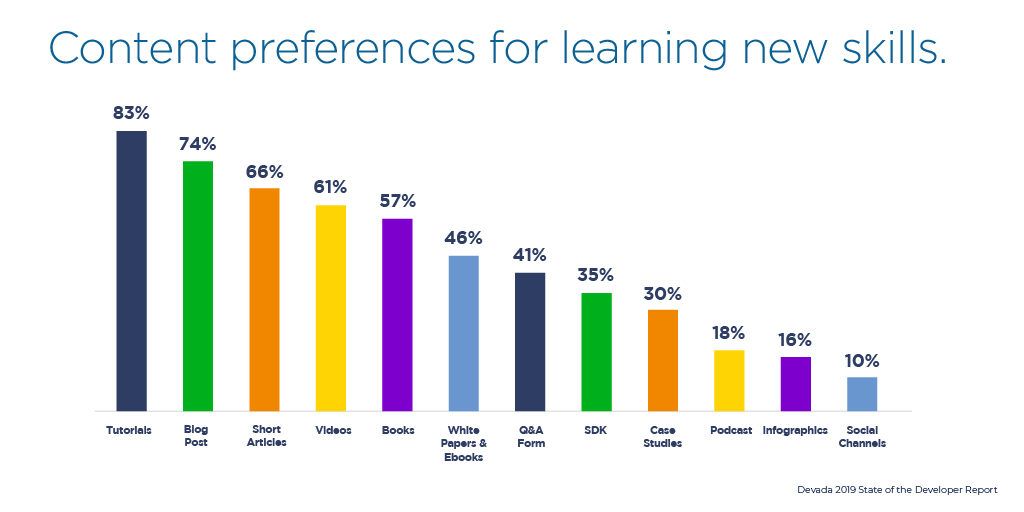Developer Support Best Practices
 Jesse Davis
Jesse Davis
What does it take to build and support developer communities? In this article, EVP of Product for Devada Jesse Davis shares insights from the 2019 State of the Developer Report and gives advice to organizations that want to level up their own developer support strategies and practices.
When we surveyed developers earlier this year we weren’t surprised by this result: 77% said they research and solve challenges themselves. A mere 3% willingly reach out to vendor technical support for issues with the tools they use (and that’s probably because their manager told them to.). They usually try to figure things out themselves.
Are the technical support ticketing systems in use failing? A stubborn streak of independence? It’s really just the nature of developers – they are attracted to the coding because they like to solve problems.
Understanding this should feed into how you design a support system for your products. How do you make sure developers are learning how to get the most from your products, sharing best practices with other users, and getting the latest features and updates in a way that helps them stay up to date on your technology? How can your support site increase their productivity and turn them into happy, satisfied users?
Our 2019 State of the Developer Report sought answers to those questions. More than 800 developers responded to the online survey with a fairly even spread among small-, medium- and enterprise-size companies. The respondents were members and visitors to our very own DZone.com site which is one of the world’s oldest developer communities with roots going back to 1997.
We explored issues around the use of developer communities, preferred ways of learning, and factors that impact developer productivity. You can read the full report here.
In reviewing the data and thinking about what we’ve learned from working with developers, we’ve prepared a short list of best practices for helping them learn and making sure your company can deliver what they need.
1. Developers don’t want to talk to you
Don’t take it personally. Developers just aren’t into talking through an issue with a support representative. 94% of developers say you don’t need phone-based technical support and only half (48%) say they would like technical support via live chat. They prefer to find the answer on their own or by asking their peers. You’ll want to make sure to have a system that allows that — Q&A systems are what you need here.
Phone-based technical support has another huge disadvantage: It’s expensive because it is one-to-one. Does your phone support ever capture the question and answer and place it somewhere where developers can see it? You don’t want to be answering the same questions more than once, so make sure you’re capturing questions and allowing users to search for answers.
2. Separate the marketing learning curve from the technical one
You’ve likely figured out that it takes more than a marketing team to attract, communicate and work with developers. But who should be in charge of which types of content?
This bar chart from our research provides a kind of roadmap for dividing and conquering:

On the right are the content types that help you build and sustain awareness of your solution or product. On the left are the tools that help a dev use your solution and solve a problem.
Tutorials written by copywriters sound like thinly veiled sales pitches so you’ll want your technical resources writing blogs and tutorials; better yet – recruit other developers from your community to write them! You’ll still need your marketers for awareness building, crafting engaging copy, helping you create compelling podcasts and social campaigns — though we know some developers with mad tweeting skills.
Why did only 35% of respondents pick Software Development Kits? We think of SDKs as both an awareness and learning tool that takes a bit of commitment. If a developer is casually learning about your product, they might check out a blog post first. If they are already immersed in using your product, the SDK is in the rear-view mirror. If you want to engage early with an SDK it needs to be centered around the idea of ‘micro learning’ – helping the developer get something accomplished every 10 minutes. Otherwise they’ll lose interest.
Whitepapers, content for forums and video are good areas for marketing and technical to work together.
3. Understand when video works – and when it doesn’t
Speaking of video, don’t misuse it. If you need to walk a user through a simple setup, a video is a great tool. It’s also good for providing a general overview of a new way to approach a problem, or a new solution. However, it doesn’t work for solving problems when code is involved. Have you ever tried to grab a line of code from a video? It’s too much of a pain to pause the video, copy what you see there, and then continue – this is why developers prefer a blog post or tutorial.
It’s not a surprise that videos ranked as the 4th most important content style for learning new skills — behind tutorials, blog posts and short articles. Nothing will ever beat a tutorial written by a developer for a developer. You just put the tutorial on screen #2 with your IDE on screen #1 and have at it!
4. Look at an online community as a technical support option
Developers like communities and they expect you to have one if you have a solution that they’ll be using. Our survey results show that 88% of those surveyed agree or strongly agree that vendors should provide their own online community!
Rather than having your team answer questions on public forums, offering your own community gives you control. You can moderate for good online citizenship and tag top answers, you can recruit experts to help you manage the community and answer the tough questions. Developers love to give back, so you will want a system that allows you to get their input on ideas for your platform.
I know, you’re thinking that you can handle all this with your documentation. However, documentation is no substitute for a community! By its very nature, documentation tends to be static and is certainly not updated daily. It’s never going to have answers on compiling errors or syntax issues. Think of it this way: You get a new phone and you go to link it to your car’s Bluetooth. If it doesn’t work, the car’s documentation isn’t necessarily going to help because it won’t cover every version of every phone on the market.
Vendor-sponsored communities offer a conversation and give and take with answers coming from the company and from experienced users, plus options to upvote and accept answers. It’s a dynamic, interactive and vibrant way to work with and engage with developers. It’s really all about providing a place online where developers belong; give them a place where they can build relationships with people using your technology. Result: You win.
Some companies that want developers to build on their platform have bypassed traditional support systems, standing up a community to supply the support that devs need. Many companies worry that standing up a community will cause friction with enterprise customers that are used to the “white glove” treatment; however, what we see is that when using communities the time to get an answer and full solution actually decreases! With a community, you’re crowdsourcing each and every problem which is more effective than sitting in a queue waiting for the next available customer support representative to take a look.
5. Change up your communication style with existing customers
You’ve got developers actively using your product. Maybe you’ve launched a developer community to help answer their questions. How do you let them know that there is a new product or a resource available?
Every developer marketer’s first inclination would be to craft an email. Don’t go there. Developers prefer a post in your community (a blog or sticky announcement works great!) Sixty percent of those surveyed said that this method will work better for them instead of more e-mail. It was nearly double the second favorite choice — announce the news on a forum. Emails ranked 6th at 26%. You might alert users of the blog in an email packaged with other news. We think that should be okay with your devs – assuming that’s one email a month. Just one.
One last note on helping developers solve challenges
When it comes to supporting developers there isn’t a magic bullet; however, there are some targeted technologies out there to help you build your community and make some happy developers. You’ll need to have a strategy and programs to support your community; these programs coupled with great community software are a powerful combination to get more developers using your products.
Just make sure you are choosing solutions that will scale as your business grows. This will help you build the kind of lasting relationships with your developers that will yield surprisingly (positive) results.
To learn more about this topic, check out our key insights from Building Vibrant Developer Communities, a panel of DevRel experts moderated by Jesse at the Heavybit Clubhouse, or watch a recording of the full panel here.
Subscribe to Heavybit Updates
You don’t have to build on your own. We help you stay ahead with the hottest resources, latest product updates, and top job opportunities from the community. Don’t miss out—subscribe now.
Content from the Library
Why Developer Communities are Essential for DevTools Startup Growth
As end-users and increasingly purchasing decision-makers, developers are an important audience for DevTools software teams. In...
Generationship Ep. #47, The Tech Bros with Milette Gillow and Sedinam Simpson
In episode 47 of Generationship, Rachel Chalmers chats with Dr. Milette Gillow and Sedinam Simpson, co-founders of The Tech Bros,...
How It's Tested Ep. #16, Test-Driven Development Demystified with Jon Jagger
In episode 16 of How It’s Tested, Eden speaks with Jon Jagger, Director of Software at Kosli. The conversation dives into Jon's...